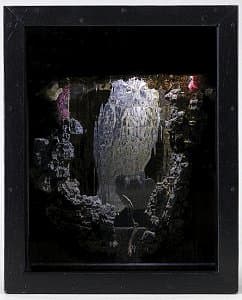

Joseph Cornell
Learn moreUntitled (Owl box) c.1946-48
© Joseph Cornell. VAGA/Copyright Agency Purchased 1980
More detail | PermalinkJoseph Cornell was acquainted with many émigré European artists, including a number of Surrealists who settled in or moved through New York. Their ideas inflect his work and his creations were, in turn, influential in introducing these ideas further afield. An avid collector, Cornell scoured Manhattan’s antique bookshops and second-hand stores for paper ephemera and small objects to make his signature glass-fronted boxes. His first box was shown in the Fantastic Art, Dada, Surrealism exhibition at the Museum of Modern Art, New York, in 1936. From his knowledge of European culture, art and literature the reclusive artist, who never travelled beyond New York, created his own microcosms, self-contained worlds in which to explore life hermetically.
Cornell worked on owl boxes from the early 1940s to the mid 50s, keeping track of them in his diaries.[i] While birds were a common feature of his boxes, his owl constructions, such as Untitled (Owl box) c#1946–48, have a particular character, placed in diorama-type settings that he referred to as ‘woodland habitats’ or ‘deep forest interiors’. In this box, a secret world of undergrowth constructed from pieces of dry wood and lichen surrounds the owl—an illustration glued to a plywood backing. Wood dust adhered with glue covers exposed areas of the inner plywood frame, while several streaks of gold paint are dripped onto the bark and the back wall. At the top of the box is a lamp fitting hidden by the frame. The habitat becomes visible only when this lamp is switched on, taking on a soft blue tint from the rippled blue glass pane, against which the eyes of the owl are yellow and bright. The owl appears as if seated in its bower in shimmering distant moonlight.
Lucina Ward[ii]
[i] Several entries record Cornell’s processes; the entry for 15 April 1946, for example, reads: ‘discovery for the owl box in progress a particularly fine example of rotted tree from which a piece of bark and clinging trailing shrubbery branches had fallen. Took off by the handful the wood from outer part of trunk which was in a powder state-lined box that evening …’ Archives of American Art, Smithsonian Institution, Joseph Cornell Papers, diaries, undated and 1930–72 (reel 1059, frame 365). Other owl boxes include Untitled (Owl box) 1945–46, Musée National d’Art Moderne, Paris and Untitled (Owl) c#1948–50, Joseph Cornell Collection, Chicago.
[ii] Adapted and updated from Michael Lloyd and Michael Desmond, European and American paintings and sculptures 1870–1970 in the Australian National Gallery, Australian National Gallery, Canberra, 1992, pp 224–5.

